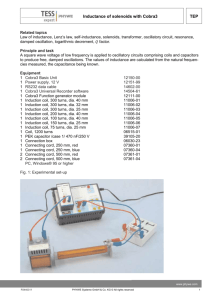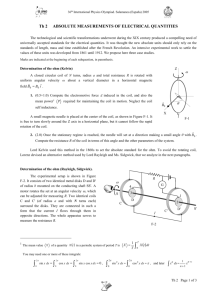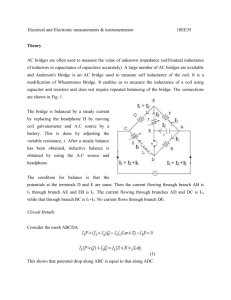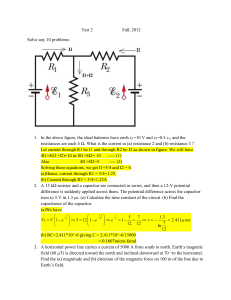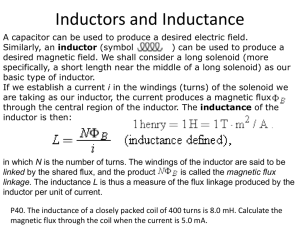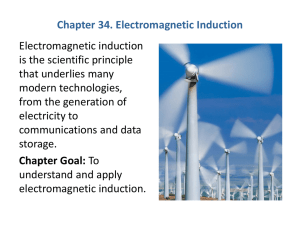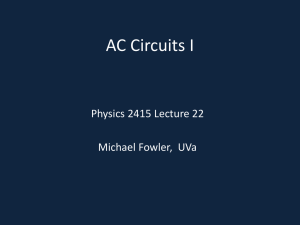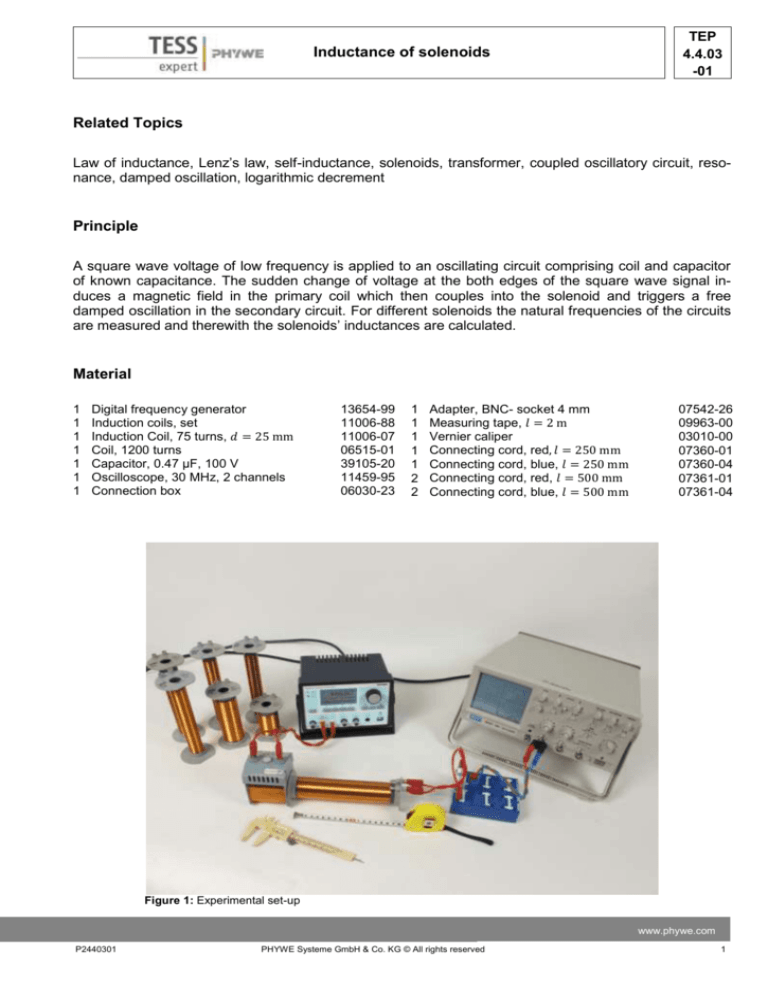
Inductance of solenoids
TEP
4.4.03
-01
Related Topics
Law of inductance, Lenz’s law, self-inductance, solenoids, transformer, coupled oscillatory circuit, resonance, damped oscillation, logarithmic decrement
Principle
A square wave voltage of low frequency is applied to an oscillating circuit comprising coil and capacitor
of known capacitance. The sudden change of voltage at the both edges of the square wave signal induces a magnetic field in the primary coil which then couples into the solenoid and triggers a free
damped oscillation in the secondary circuit. For different solenoids the natural frequencies of the circuits
are measured and therewith the solenoids’ inductances are calculated.
Material
1
1
1
1
1
1
1
Digital frequency generator
Induction coils, set
Induction Coil, 75 turns, 𝑑 = 25 mm
Coil, 1200 turns
Capacitor, 0.47 µF, 100 V
Oscilloscope, 30 MHz, 2 channels
Connection box
13654-99
11006-88
11006-07
06515-01
39105-20
11459-95
06030-23
1
1
1
1
1
2
2
Adapter, BNC- socket 4 mm
Measuring tape, 𝑙 = 2 m
Vernier caliper
Connecting cord, red, 𝑙 = 250 mm
Connecting cord, blue, 𝑙 = 250 mm
Connecting cord, red, 𝑙 = 500 mm
Connecting cord, blue, 𝑙 = 500 mm
07542-26
09963-00
03010-00
07360-01
07360-04
07361-01
07361-04
Figure 1: Experimental set-up
www.phywe.com
P2440301
PHYWE Systeme GmbH & Co. KG © All rights reserved
1
TEP
4.4.03
-01
Inductance of solenoids
Tasks
Figure 2: Schematic circuit of the set-up. L is the primary coil
with 1200 turns, L1 labels the solenoid in the secondary circuit.
The natural frequency of the induced oscillation
has to be measured each induction coil. From the
natural frequency and the known capacitance calculate the inductances of the coils and determine
the relationships between
1. inductance and number of turns,
2. inductance and solenoid length
3. as well as inductance and solenoid radius.
Set-up
Perform the experimental set-up according to Figs. 1 and 2. Set the digital function generator to an amplitude of 20 V, frequency of 500 Hz or lower and to the square wave signal with signal-type out. The solenoid has to be aligned carefully with the primary coil so that the magnetic field can couple efficiently
from the primary coil into the solenoid. The distance between the two coils should be maximized so that
the effect of the excitation coil on the resonant frequency can be disregarded. there should be no iron
components in the vicinity of the coils.
The tolerance of the oscilloscope time-base is given as 4 %. If a higher degree of accuracy is required,
the time-base can be calibrated for all measuring ranges with the digital function generator prior to these
experiments.
Procedure
For each solenoid the settings of the oscilloscope have to be adjusted in such manner, that one damped
oscillation can be fully seen on the screen and the peaks are clearly distinguishable as shown in fig. 3.
The time between two peaks of the damped oscillation is the actual period length of the natural frequency and can be easily read from the screen by shifting the wave into appropriate positions. The lengths of
the solenoids have to be measured with the measuring tape, the radius (i.e. the diameter) has to be de-
Figure 3: Damped oscillation on the oscilloscope. The actual settings can vary for differing coils.
2
PHYWE Systeme GmbH & Co. KG © All rights reserved
P2440301
TEP
4.4.03
-01
Inductance of solenoids
termined with the vernier caliper and the numbers of turns are given.
Theory
If a current of strength 𝐼 flows through a cylindrical coil (a.k.a. solenoid) of length 𝑙, cross sectional area
𝐴 = 𝜋 ∙ 𝑟 2 , and number of turns 𝑁, a magnetic field is set up in the coil. When 𝑙 ≫ 𝑟 the magnetic field is
uniform and the field strength 𝐻 is given by
𝐻=𝐼∙
𝑁
𝑙
(1)
The magnetic flux Φ is given by
Φ = 𝜇0 𝜇 ∙ 𝐻 ∙ 𝐴
(2)
where 𝜇0 is the magnetic field constant and 𝜇 the absolute permeability oft he surrounding medium.
When this flux changes it induces a voltage between the ends of the coil,
𝑈𝑖𝑛𝑑 = − 𝑁 ∙
𝑑Φ
𝑑𝑡
= − 𝑁 ∙ 𝜇0 𝜇 ∙ 𝐴 ∙
=−𝐿∙
𝑑𝐻
𝑑𝑡
𝑑𝐼
𝑑𝑡
(3)
where
𝐿 = 𝜇0 𝜇 ∙ 𝜋 ∙
𝑁 2 ∙𝑟 2
𝑙
(4)
ist he coefficient of self-induction (inductance) of the coil.
In practice the inductance of coils with 𝑙 > 𝑟 can be calculated with greater accuracy by an approximation formula
𝐿 = 2.1 ∙ 10
for 0 <
𝑟
𝑙
−6
2
∙𝑁 ∙𝑟∙
3
𝑟 ⁄4
(𝑙 )
(5)
< 1.
In the experiment the inductance of various coils is calculated from the natural frequency of an oscillating
circuit:
𝜔0 =
1
√𝐿𝐶𝑡𝑜𝑡
𝐶𝑡𝑜𝑡 = 𝐶 + 𝐶𝑖 is the sum of the known capacitor and the input capacitance 𝐶𝑖 ≈ 30 pF of the oscilloscope,
which exercises a damping effect on the oscillatory circuit and causes a negligible shift (approx. 1 %) in
the resonance frequency.
The inductance is therefore represented by
𝐿 = (4𝜋 2 𝜈02 𝐶)−1
(6)
www.phywe.com
P2440301
PHYWE Systeme GmbH & Co. KG © All rights reserved
3
TEP
4.4.03
-01
Inductance of solenoids
Tab. 1: Coil data and calculated inductances (see eq. 5).
Coil
N
1
2
3
4
5
6
7
𝑁
2𝑟
in mm
𝑙
in mm
𝐿𝑐𝑎𝑙𝑐
in µH
300
300
300
200
100
150
75
41
33
26
41
41
26
26
160
160
160
105
50
160
160
830
568
374
506
221
93
23
Tab. 2: Measured natural frequencies and inductances
from eqs. (5) and (6).
Coil No.
1
2
3
4
5
6
7
T
in µs
130
100
80
100
64
40
20
𝜈
in kHz
7.7
10
12.5
10
15.6
25
50
𝐿𝑒𝑥𝑝
in µH
𝐿𝑐𝑎𝑙𝑐
in µH
911
539
345
539
221
86
22
830
568
374
506
221
93
23
𝜔
1
where 𝜈0 = 2π0 = 𝑇∙2𝜋 is the natural frequency with
𝑇 being the period of the oscillation.
Evaluation and results
In the following the evaluation of the obtained values
is described with the help of example values. Your
results may vary from those presented here.
From equation (5) we obtain the theoretical inductance values of the used coils. These are listed in table 1.
The following coils provide the relationships between
inductance and radius, length and number of turns
that we are investigating:
1. no. 3, 6, 7
2. no. 1, 4, 5
3. no. 1, 2, 3
As a difference in length also means a difference in
the number of turns, the relationship between inductance and number of turns found in task 1 must
also be used to solve task 2.
In table 2 the measured natural frequencies are
shown as well as the calculated values for 𝐿 from relations (5) and (6) respectively. The experimental
values 𝐿𝑒𝑥𝑝 are in good agreement with the theoretically expected values 𝐿𝑐𝑎𝑙𝑐 with a standard deviation
of approximately 6%. The coils with higher inductances show rather considerable deviations. As the
inductance is proportional to the square of the oscillation’s period length, this scatter is hard to reduce
because especially for long-period oscillations the
oscilloscope’s accuracy is limited.
1. Task: Determine the coils’ relationships between
inductance and number of turns.
To determine the relationship between inductance
and number of turns consider coils with identical radius and length but different number of turns. The Coils
no. 3, 6 and 7 meet these requirements.
In figure 5 the corresponding inductances are plotted
in dependence of the number of turns.
Fitting the expression 𝐿𝑒𝑥𝑝 = 𝑎 ∙ 𝑛𝑏 to the experimental values yields
𝑏 = 2.0003
Fig. 4: Comparison of inductances 𝑳𝒄𝒂𝒍𝒄 with 𝑳𝒆𝒙𝒑 calculated from equations (5) and (6) respectively.
4
which is in excellent agreement with the theoretical
value 𝑏𝑡ℎ𝑒𝑜 = 2 (see eq. 5).
PHYWE Systeme GmbH & Co. KG © All rights reserved
P2440301
Inductance of solenoids
TEP
4.4.03
-01
2. Task: Determine the coils’ relationships between
inductance and length of coil.
To determine the relationship between inductance
and length of coil consider coils with identical radius
but different lengths. The Coils no. 1, 4 and 5 meet
these requirements. As the relation between inductance and number of turns is already known, the inductances can be normalized by the number of turns.
Therefore consider the relationship between inductance normalized by turn number squared and the
length of coil. In figure 6 the corresponding values are
plotted in dependence of the coil length.
𝐿
Fitting the expression 𝑒𝑥𝑝⁄ 2 = 𝑎 ∙ 𝑙 𝑏 to the experi𝑛
Fig. 5: Relation between inductance and number of turns.
mental values yields
𝑏 = −0.67
which is in fair agreement with the theoretical value
𝑏𝑡ℎ𝑒𝑜 = −0.75 (see eq. 5).
3. Task: Determine the coils’ relationships between
inductance and radius of the coils.
To determine the relationship between inductance
and radius of coil consider coils with identical lengths
but different radii. The Coils no. 1, 2 and 3 meet these
requirements. As the relation between inductance and
number of turns is already known, the inductances
can be normalized by the number of turns. Therefore
consider the relationship between inductance normalized by turn number squared and the radius of the Fig.6: Relation between inductance and length of coil.
coils. In figure 7 the corresponding values are plotted
in dependence of the coil radius.
𝐿
Fitting the expression 𝑒𝑥𝑝⁄ 2 = 𝑎 ∙ 𝑙 𝑏 to the experi𝑛
mental values yields
𝑏 = 1.82
which is in good agreement with the theoretical value
𝑏𝑡ℎ𝑒𝑜 = 1.75 (see eq. 5).
Fig. 7: Relation between inductance and radius of the coil.
www.phywe.com
P2440301
PHYWE Systeme GmbH & Co. KG © All rights reserved
5
TEP
4.4.03
-01
6
Inductance of solenoids
PHYWE Systeme GmbH & Co. KG © All rights reserved
P2440301

